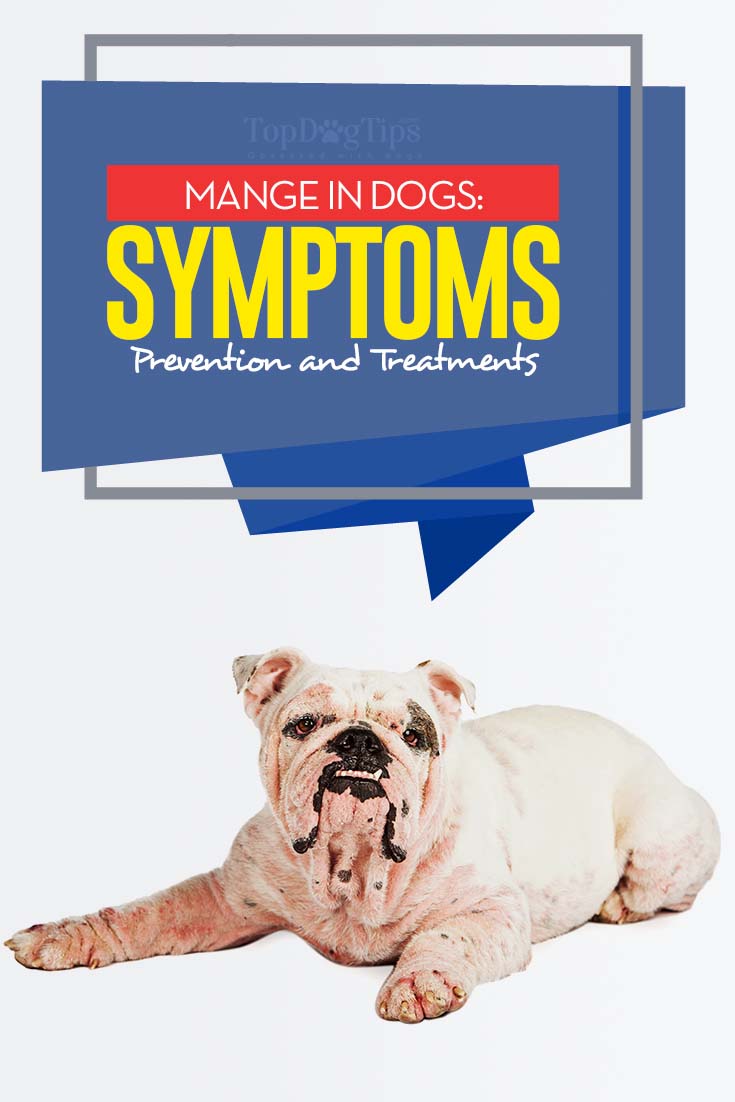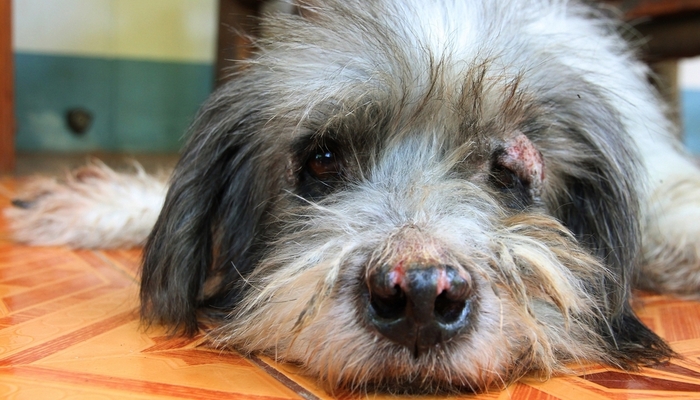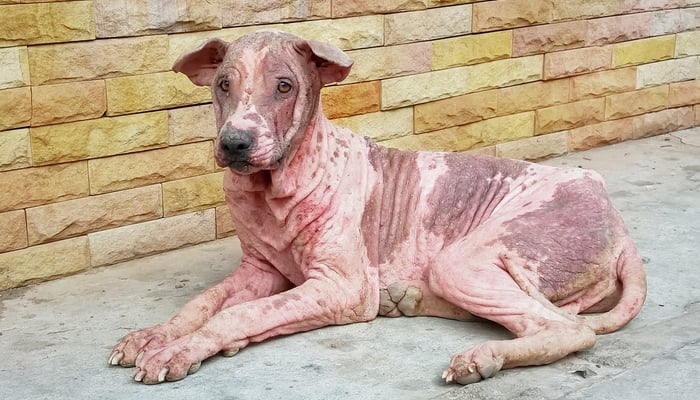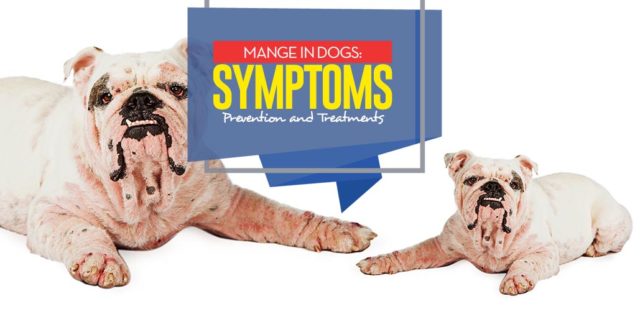
Skin conditions known as mange in dogs can be extremely irritating for your pet. It starts out slowly, but if not treated, it will quickly spread.
The symptoms vary, as do the treatments. If you suspect your dog has mange, it's best to seek veterinary care as soon as possible.
Mange in dogs is caused by one of three different types of mites:
The Demodectic Mite, which all dogs have, only becomes a problem when the volume of these critters becomes unmanageable.
The Sarcoptic Mite is the most dangerous and causes extreme itching. They can make your dog scratch his skin raw.
Finally, the mange in dogs can be caused by the Cheyletiellosis Mite – often referred to as walking dandruff.
The symptoms of mange in dogs vary, depending on the type of mange that your pet is suffering from, but in general, symptoms will include:
- scratching
- hair loss and bald patches
- reddening of the skin
- weight loss
Depending on the severity of the mange, you may be able to treat it fully at home by using a store-bought shampoo or homemade solution to kill off the mites.
If your dog has any bleeding on the skin, head to your local veterinarian so they can inspect the wounds for infection.
Now, let's talk about what mange in dogs actually is, how to treat it, and (most importantly) how to prevent this serious skin condition.
ALSO READ: 5 Best Remedies for Dog’s Dry or Itchy Skin, Paws and Nose
Mange in Dogs
symptoms, prevention, and treatments
What is mange in dogs?
There are three kinds types of Mange that your dog can suffer from, each caused by different mites.
The most dangerous and uncomfortable type of mange by far is Sarcoptic Mange, more commonly known as Scabies.
This highly infectious skin disease is easily passed on from dog to dog, and I’m sad to say — it’s contagious for us humans, too.
The Sarcoptic Mite is the little scoundrel responsible for this condition; they bite and burrow into your dog’s skin, causing him to scratch the affected areas fervently.
It’s this fussing that causes hair loss and skin irritation.
And, if left untreated, your dog runs the risk of acute infection and anemia.
The secondary and less severe type of Mange is Demodectic Mange.
Demodectic Mites usually live in harmony with your dog.
This is picked up in the first few days of life, passed on from mother to puppy, and ordinarily causes no problem. That is until the number of mites becomes unmanageable.
There are two levels of infection with Demodectic Mange – localized and generalized.
In localized Demodectic Mange, only a small area of the body is affected. However, in a generalized case, the outbreak usually begins on the muzzle and head before progressing across the entire body.
 The third, final, and least common type of mange is Cheyletiellosis.
The third, final, and least common type of mange is Cheyletiellosis.
Often mistaken for dandruff, the Cheyletiellosis Mite is white and slow-moving.
By taking a piece of tape and removing some of these white flecks off of your dog’s coat, you should be able to determine whether you’re dealing with dandruff or mites.
Alternatively, a quick test by your veterinarian will be able to figure it out.
Who can suffer from mange?
Unfortunately, any dog of any breed, age, size, and color can contract mange — and many do at some point in their lives.
The most common way for them to pick it up is through contact with another infected animal or human.
Some owners worry that their dog may be able to pick it up from a dog bed or dog toy, but it’s highly unlikely — as both Sarcoptic and Demodectic Mites are unable to survive for very long at all without a host.
Should your dog go lay on a bed that an infected dog has just gotten up from, then yes, there is a chance that he can become infected.
Kennels, rescue centers, doggy daycares, veterinarians, and grooming parlors have the highest exposure to mites. For this reason, many have policies for frequent bathing with mite-killing shampoos.
Even when these policies aren’t in place, it’s highly advised for owners to take preventative action just in case. After all, you don’t want to risk becoming infected yourself.
RECOMMENDED: How I Keep My Dog's Skin and Coat Healthy
Common symptoms of mange in dogs
We’ve all heard of mange in dogs and seen the horror stories of rescued dogs with no hair on their body from having such a severe case of untreated mange.
Because of this, we all know that the most common symptom for mange in dogs is severe scratching.
The symptoms depend on what variety of diseases your dog is suffering from. With Demodectic Mange, your dog can develop:
- hair loss
- full-on bald spots
- scabs
- sores
Sarcoptic Mange tends to manifest itself more severely with:
- unbearable itching, causing your dog to draw blood
- lesions on the face, elbows, ears, and legs
- hair loss
- reddened skin
Cheyletiellosis Mange isn’t usually as severe as Sarcoptic, but as with any mange, anemia is a significant danger. Symptoms to look out for include:
- dandruff appearance
- scratching
- thickening of the skin
- reddened skin
Who else is susceptible to mange?
As well as afflicting dogs, cats, and people, mange can also affect wild animals such as coyotes and bears.
And, wouldn’t you know it, the farmyard isn’t safe from this itchy and miserable condition either.
Sheep and goats are also prone to this skin disease.
RELATED: 5 Best Fish Oil for Dogs Supplements to Aid the Skin
Real-life case of mange in dogs
Stories of dogs suffering from extreme cases of mange are becoming commonplace all over the world.
Sadly, this ailment is so easy to treat if dealt with early on, and yet, these stories just go to show that even in the most severe cases of neglect, there is hope.
One such story was the story of Billy, a stray dog from Greece.
Spotted from a train window by Valia, a volunteer at one of the animal rescue organizations in Greece, Valia snapped a photo of Billy to try and figure out who this dog was and how they could get him some help in what looked like his final few days of life.
She posted the photo on social media, and many of her friends thought that this wasn’t a real dog.
Billy was so extremely emaciated and mange-ridden that he looked more like an artist’s depiction of a hellhound than a real, living, and breathing pooch.
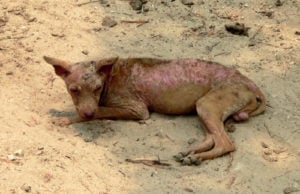 After setting the record straight and confirming the sad news that this was a real-life dog, help was immediately scrambled and sent on the forty-mile journey to retrieve Billy.
After setting the record straight and confirming the sad news that this was a real-life dog, help was immediately scrambled and sent on the forty-mile journey to retrieve Billy.
Upon arriving at the vet's office in Athens, Billy was petrified – and it’s clear as to why.
This dog had not felt the love and protection of a human in quite some time – if ever.
Valia set up a little bed in the downstairs bathroom of her home and left Billy to rest for several days, only disturbing his sleep by offering food four times per day.
At ten days post-rescue, a miracle happened. Billy started to make it clear that he wasn’t giving up without a fight.
Much to the joy and surprise of everyone who saw him in his worst state, Billy made a full recovery and learned to love people again.
Valia secured a forever home for Billy, and he now spends his days galavanting around the gorgeous scenery of Switzerland with his owner, Emma.
It is a happy ending to a tragic beginning.
RECOMMENDED: Ear Mites In Dogs – Symptoms, Natural and Veterinary Treatments, Prevention
Preventing mange in dogs
The likelihood of your dog contracting mites at some point is high, but if treated quickly — it shouldn't progress to a serious problem.
The only real way to prevent the spread of Sarcoptic Mites is by not socializing your dog with any other dogs, which isn’t practical.
Home treatments for mange in dogs
Many home treatments can work well to treat milder cases of mange.
If your dog is suffering from significant skin irritation, it’s recommended to seek your veterinarian's opinion before treating it at home.
Underlying infections are one of the biggest dangers for dogs with mange.
Combining water, hydrogen peroxide, and borax will make a solution that will kill the mites without being detrimental to the health of your dog.
This mixture should be applied to the dog’s skin and left to sit for several hours. Repeat multiple times over two or three days to ensure that you eliminate all mites.
 A more natural option is to combine water with apple cider vinegar. Spray this solution onto your dog’s fur, combing it in to ensure maximum coverage.
A more natural option is to combine water with apple cider vinegar. Spray this solution onto your dog’s fur, combing it in to ensure maximum coverage.
For additional benefit, you can add some apple cider vinegar to your dog’s food as well.
To relieve itching and pain, especially on raw areas of skin, apply honey and let it sit for a few hours.
The natural antiseptic of the honey will help to heal the skin and also contribute to killing off any remaining mites.
Giving your dog a bath and applying ointments will only go so far. A deep clean of all of his belongings will be required.
Where possible, clean with boiling water. For more delicate items, a thorough cleaning is better than nothing.
As most mites cannot survive for a prolonged period without a host, it’s advised to keep these things outside for a few days to ensure that the mites are long gone and then clean them again.
RELATED: 6 Uses and Health Benefits of Honey for Dogs
Veterinary treatments for mange in dogs
Depending on the severity and type of mange, different kinds of treatment can be utilized, including:
- oral medication
- shampoo or dip
- quarantine
- antibiotics for infection
Mange in Dogs: Before You Go…
Your dog will likely come into contact with mites on a relatively frequent basis, from playing at the dog park to walking down the street.
Symptoms of mange can take between two and six weeks to show post contact with an infected animal, and once the mites take hold and your dog begins to show the symptoms of mange — it can be very easy to treat.
In a multi-dog household, it’s important to treat all dogs with an anti-mange shampoo or dip.
And if possible, keep the infected dog away from your other pets during treatment.
Treatment for mange is reasonably inexpensive, costing more if an infection has set in.
In general, your veterinarian will conduct an initial exam and provide you with instructions to continue treatment at home.
READ NEXT: 15 Cheap Ways To Prevent Most Common Health Issues In Dogs
